Ramen Recipes: Homemade Comfort Food

Ever thought a simple bowl of Ramen could turn a meal into a flavor fest? Homemade Ramen with savory noodles and juicy chicken is a treat. Quick meals like these add soft boiled eggs, green onions, and mushrooms to Japanese noodles, making them even better.
Homemade Ramen, made with rich broths and spices, is more than just food. It’s a soul-soother. And it’s ready in about 30 minutes, perfect for busy nights. It’s simple yet deeply satisfying.
Each bowl is full of good stuff – 511 kcal, 27g of protein, and 39g of carbs. It’s great after a long day or when sharing with family. These easy recipes change how we see comfort food.
The Origins of Ramen: A Brief History
Ramen’s history shows how cultures blend and food evolves. It started in Japan with Chinese immigrants. Over time, it grew from simple noodles in broth to the beloved dish we know today.
The Influence of China on Japanese Ramen
The thick noodles and soy sauce broth show China’s mark on Ramen. Even in the early 1900s, Japanese restaurants served Ramen with Chinese flavors. The first Ramen shop, Rairaiken, opened in 1910 in Tokyo, making Ramen popular in Japan.

Traditional vs. Modern Interpretations
Japanese noodles in Ramen have changed a lot over time. At first, it was “shina soba,” a hearty dish with thick noodles and rich broths. In the 1950s and 1960s, new styles like tonkotsu and miso Ramen came, adding modern flavors.
Now, Ramen has many flavors and ingredients, showing ongoing creativity. Instant Ramen, introduced in 1958, made Ramen quick and affordable after WWII. This change made Ramen popular worldwide.
| Era | Event/Development |
|---|---|
| 1859 | First known instance of Ramen in Japan |
| 1910 | First Ramen shop, Rairaiken, founded in Tokyo |
| 1928 | First appearance of the term “ramen” in Japan |
| 1945-1952 | American military occupation of Japan, boosting Ramen popularity |
| 1958 | Introduction of instant Ramen by Momofuku Ando |
| 1960s | Introduction of various Ramen styles like tonkotsu and miso |
| 1971 | Instant Ramen exported internationally |
Essential Ingredients for Perfect Ramen
To make perfect ramen, focus on noodles, broth, and toppings. These parts work together for a great taste. It’s fun for anyone, from beginners to experts.
Noodles: Types and Their Characteristics
Ramen noodles vary, each adding its own taste and feel. Traditional noodles are made from wheat flour, salt, water, and kansui. This makes them chewy. Here are some types:
- Thin noodles: Great for light broths like shoyu or shio.
- Thick noodles: Best for thick broths like miso or tonkotsu.
- Curly noodles: Perfect for holding onto broth, making every bite tasty.
Choose noodles that match your broth and toppings for a tasty bowl of ramen.
Broths: Bases That Make a Difference
The broth is key to great ramen. Here are some classic ones:
- Shoyu: Soy sauce-based, rich in umami flavor.
- Miso: Soybean paste adds a deep, complex taste, often with thick noodles.
- Tonkotsu: Creamy pork bone broth, simmered for hours for a deep taste.

Homemade broth can make any noodle soup better. For a quick fix, use 4 cups of chicken or vegetable broth. Add 1 ounce of dried shiitake mushrooms for extra umami.
Toppings: From Chashu to Soft Boiled Eggs
Ramen toppings add flavor and texture. They turn simple noodles into a gourmet dish. Some favorites are:
- Chashu: Braised pork belly, soft and flavorful.
- Nitamago: Soft-boiled eggs marinated in tare for 6-12 hours.
- Nori: Seaweed sheets, adding umami and crunch.
- Fresh vegetables: Add shredded carrots, chopped kale, and scallions for nutrition.
- Sriracha and panko crumbs: Use Sriracha to taste, topped with crunchy panko crumbs.
Try different ingredients to make your ramen unique. Every bowl can be special.
Easy Homemade Ramen Recipes for Beginners
For beginners, Easy Ramen recipes like Classic Shoyu Ramen and Simple Miso Ramen are perfect. They use simple ingredients and easy steps. This way, anyone can make a tasty bowl of Ramen at home.
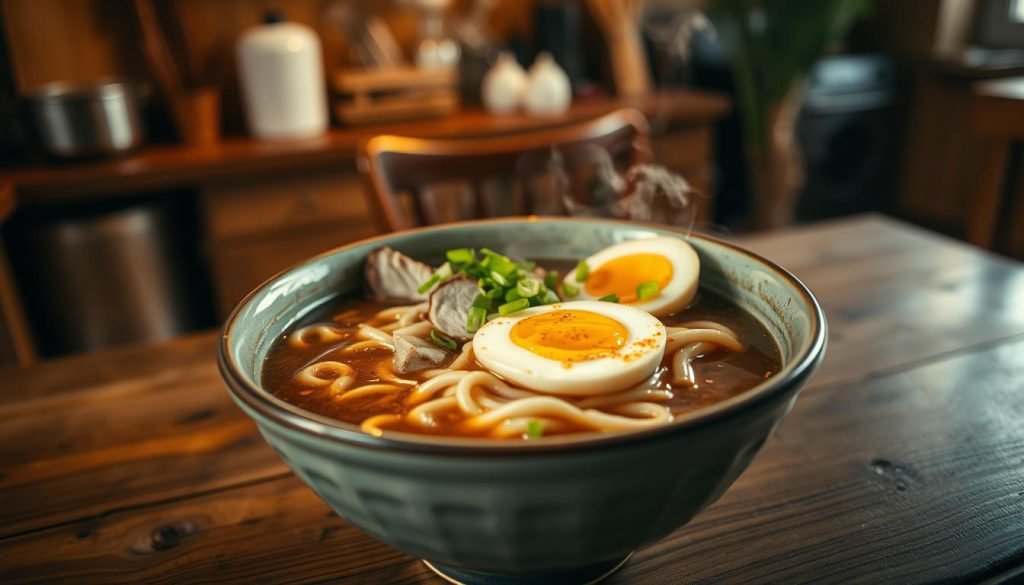
Classic Shoyu Ramen
Shoyu Ramen is a great recipe for beginners. It serves 2 people and is easy to make. Start by sautéing 2 teaspoons of garlic in 2 tablespoons of butter for a minute.
Add 1 tablespoon of soy sauce for flavor. For a bit of heat, add ½ teaspoon of red pepper flakes. Then, add 1 teaspoon of brown sugar to balance the taste.
Cook 2 boneless, skin-on chicken breasts at 375°F for 15-20 minutes. Sear each side for 5-7 minutes first. Cook 2 (3 oz) packs of ramen noodles in a pot, but skip the flavor packet.
Once the noodles are done, mix them with 4 cups of chicken stock. Add the cooked chicken, ½ cup of sliced scallions, and 2 large soft-boiled eggs. Serve right away and garnish with ½ teaspoon of everything seasoning.
Simple Miso Ramen
This Miso Ramen recipe is easy and great for beginners. It can be made in under 1 hour or 30 minutes with store-bought chicken. Start by making 4 cups of chicken stock in a pot.
Add 3 tablespoons of soy sauce and 1 oz of dried shitake mushrooms (or 0.5 cups fresh) for extra flavor. Cook 2 (3 oz) packs of dried ramen noodles for 2-3 minutes until they’re soft but still chewy.
Remove the noodles from the pot and set them aside. Add a couple of teaspoons of sea salt and ½ teaspoon of red pepper flakes to the stock. Adjust the seasoning to your taste. Add sliced fresh scallions (½ cup) and optional fresh jalapeño or chili slices for extra heat.
Assemble the ramen by placing noodles in bowls, pouring hot miso broth over them, and topping with chicken slices and soft-boiled eggs. Enjoy it right away for the best taste.
| Ingredient | Measurement |
|---|---|
| Butter | 2 tablespoons |
| Garlic | 2 teaspoons |
| Soy Sauce | 3 tablespoons |
| Red Pepper Flakes | 1 teaspoon (adjust to taste) |
| Brown Sugar | 1 teaspoon |
| Chicken Breasts | 2 boneless, skin-on |
| Chicken Stock | 4 cups |
| Ramen Noodles | 2 (3 oz) packs |
| Fresh Scallions | ½ cup, sliced |
| Soft-Boiled Eggs | 2 (7-8 minutes cooking) |
| Everything Seasoning | ½ teaspoon |
| Dried Shitake Mushrooms | 1 oz (or 0.5 cups fresh) |
| Sea Salt | 1-2 teaspoons |
Regional Variations of Ramen Across Japan
Japan has many different Ramen types, each with its own special taste. These flavors come from local ingredients and tastes. Two famous types are Tonkotsu Ramen from Kyushu and Hokkaido Ramen with miso broth.
Tonkotsu: Rich and Creamy Flavors
Tonkotsu Ramen is known for its creamy pork bone broth. It comes from the Kyushu region. This ramen shows Japan’s deep flavors and thick broth.
It became famous after “Umakacchan” instant ramen came out in 1979. Hakata Ramen from Fukuoka City also became popular in the 1980s. It has a special “kaedama” system for extra noodles.

Hokkaido Style: Miso Ramen
Hokkaido Ramen uses miso broth, loved for its deep flavors. Sapporo is where Miso Ramen started. It uses strong miso paste that goes well with Hokkaido’s cold weather.
This ramen style became famous in the late 1960s. It inspired many “Sapporo Ramen” restaurants in Tokyo. The noodles and miso soup together are a great taste.
These two types show Japan’s rich food diversity. There are over 50 Ramen types across Japan. Each one has its own noodles and broth, showing local tastes and ingredients.
Vegetarian Ramen: Taste Without Meat
Vegetarian Ramen is a tasty treat full of flavors. It uses vegetable broths and plant-based toppings. More people are trying plant-based diets, and Ramen is a big hit.
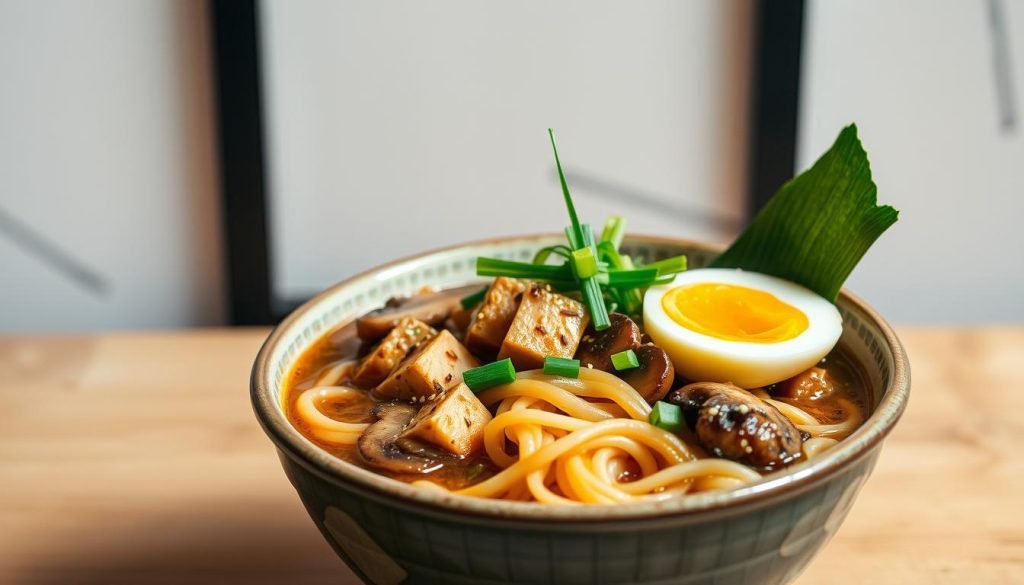
Hearty Vegetable Broths
The broth is key to great Vegetable Ramen. A good vegetable broth can taste as rich as meat broth. Start with garlic, ginger, and shiitake mushrooms in sesame oil.
- Preparation time: 25 minutes
- Simmer time after adding stock: 5 minutes
- Additional simmer time with mushrooms: 10 minutes
Add soy sauce, mirin, and white miso paste for more flavor. This makes the broth savory and umami. Use extra-virgin olive oil for a silky texture. Simmer for an hour to get a rich mushroom broth.
Plant-Based Toppings that Shine
Toppings make Vegetarian Ramen special. Different veggies add texture and color. Try these toppings:
- Corn – Adds sweetness.
- Bamboo shoots – Crunchy.
- Seasoned tofu – Adds protein.
- Baby spinach – Fresh and nutritious.
- Carrots – Shredded for crunch and color.
- Green onions – Mild onion flavor.
Plant-based Ramen is flexible and nutritious. It’s low in calories, unlike traditional Ramen. Make sure your noodles are egg-free. Here’s a table with key ingredients and times:
| Ingredient | Quantity | Preparation Time (minutes) |
|---|---|---|
| Sesame oil | 1 tablespoon | 2 |
| Garlic (minced) | 3 teaspoons | 3 |
| Ginger (grated) | 4 teaspoons | 3 |
| Soy sauce | 3 tablespoons | 1 |
| Mirin or rice wine vinegar | 2 tablespoons | 1 |
| Vegetable stock | 4 cups | 5 |
| Shiitake mushrooms | ½ cup | 5 |
| Baby spinach | 1 cup | 1 |
| Dried Ramen noodles | 2 packs | 5 |
| Shredded carrots | 1 cup | 2 |
| Sliced green onions | ½ cup | 2 |
Make delicious and healthy Ramen for any meal. Play with flavors, textures, and colors. This way, every bowl is unique and exciting.
Building Your Ramen Broth: A Step-By-Step Guide
Making the perfect Ramen broth is like an art. This guide shows how to make a basic bone broth. It’s full of collagen and flavor. You’ll also learn about quick vegan broth options. These use vegetable bases and spices for flavor, great for different diets.
Basic Bone Broth Techniques
Making a tasty bone broth for ramen takes time and patience. A good tonkotsu Ramen broth uses over 40 pounds of bones. It simmers for more than 200 hours to get the right taste and texture.
Cooking times can vary. A pressure cooker can make it in 1.5 hours. But, using a stovetop might take up to 60 hours.
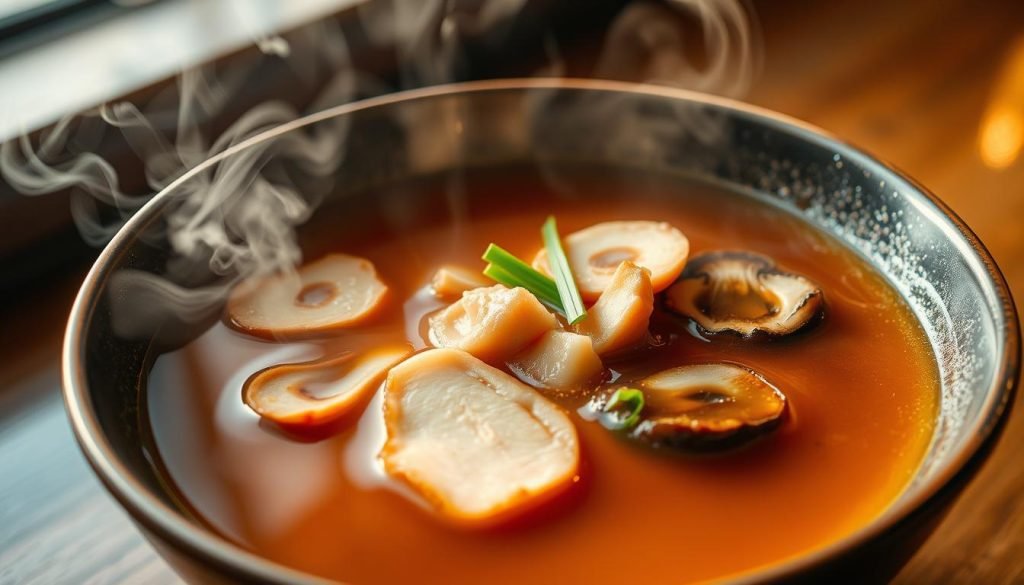
- After 1 hour: The broth is pale and watery. It has little flavor and gelatin.
- After 2 hours: The broth starts to taste better. But it’s still mostly liquid and not clear.
- After 4 hours: The broth gets clear. This means a lot of collagen has turned into gelatin.
- After 6 hours: The broth is so thick you can pick it up in softball-sized chunks. It’s very gelatinous.
- After 12 hours: The broth gets even thicker. Almost all of the pig trotters are gone.
To make 4-6 servings of ramen soup, use 1 kg (2.2 lb) of pork bones and 1-1.25 kg (2.2-2.6 lb) of chicken carcasses. Blanch the bones for 10 minutes. Then, boil all ingredients and simmer for 2 hours with a lid on. You’ll get about 1.6 liters (3.4 pints) of homemade broth.
Quick Vegan Broth Recipes
If you want a plant-based option, vegan broth recipes are great. They use vegetable bases like kombu and shiitake mushrooms. Spices add depth of flavor.
- Start with 6 cups (1.5 liters) of water.
- Add 10g of kelp, 10g of bonito flakes, and 20g (or 5) dried shiitake mushrooms.
- Soak these ingredients for about 8 hours.
- Simmer for another 3 hours after adding your dashi ingredients.
This vegan broth is a great substitute for traditional bone broth. It’s perfect for vegetarians and vegans. You can also refrigerate it for a few days or freeze it for up to a month. It’s a convenient homemade broth option.
| Broth Type | Ingredients | Cooking Time | Yield |
|---|---|---|---|
| Bone Broth | Pork bones, chicken carcasses | 6-8 hours | 4-6 servings |
| Vegan Broth | Kombu, shiitake mushrooms, spices | 11 hours total (8 hours soaking + 3 hours simmering) | 5 ramen bowls |
Ramen Toppings: Enhancing Flavor and Texture
Ramen is more than noodles and broth. It’s the toppings that make it special. They add flavor, texture, and nutrition. People love to try new toppings to make their ramen unique.
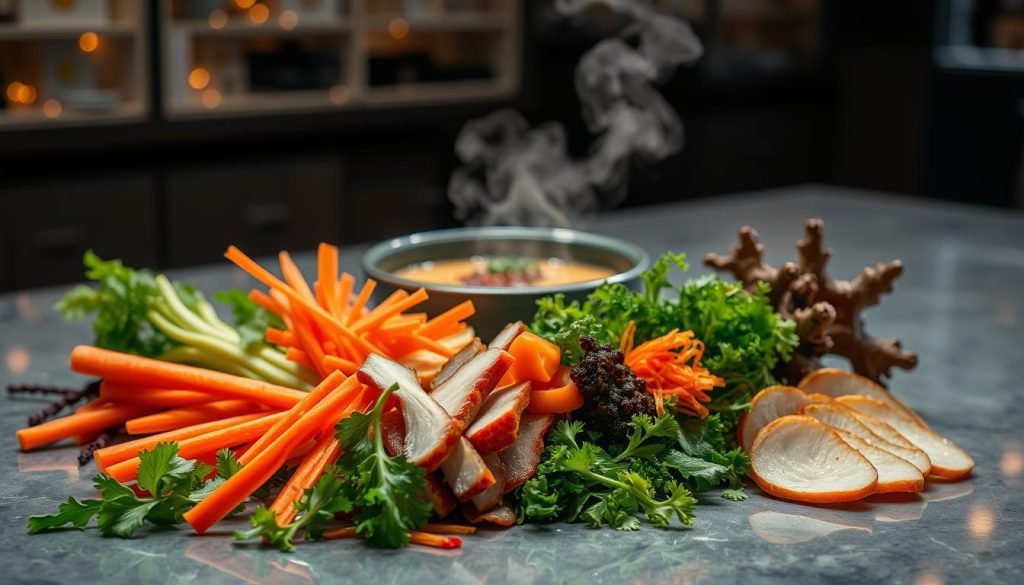
Common Toppings You Can’t Miss
Traditional ramen has many toppings. Each one adds its own taste and feel:
- Tamago (soft-boiled eggs): They’re tasty and creamy.
- Chashu (braised pork): It’s rich and umami. You usually get one or two pieces.
- Menma (bamboo shoots): They’re fermented and have a unique taste. They add fiber and texture.
- Negi (Japanese long green onions): They’re spicy but mellow when cooked. You can have them fresh or with chili.
- Nori and Wakame (types of seaweed): Nori is easy to find. Wakame adds a special touch.
- Kamaboko (fish cake): Naruto is mild and has a unique texture.
- Butter: It makes miso ramen creamier and more umami.
Innovative Topping Ideas
Want to try something new? Here are some modern toppings for your ramen:
- Kimchi: It’s spicy and healthy, adding probiotics.
- Roasted Sweet Potato: It’s sweet and soft, adding comfort.
- Crispy Onions: They add crunch, contrasting with the noodles.
- Sriracha Mayo: It’s spicy and creamy, boosting flavor by 30%.
- Grilled Chicken (Yakitori): It adds protein and smokiness.
- Braised Pork (Buta Kakuni): It’s nutritious, adding 20-30% more value.
- Spinach and Bok Choy: They’re healthy, adding color and texture.
- Sesame Garlic Sauce: It’s made from sesame oil, garlic, and spices. It balances flavors.
- Gochujang: It’s sweet and smoky, adding depth.
- Rayu (chili oil) and Yuzu Kosho: They make flavors more complex, increasing by 40%.
Try these toppings to make your ramen special. The key is balance and creativity. Each bite should be a joy.
Customizing Your Ramen Experience
Customizing your ramen bowl lets you make it just right for you. You can add spice or a bit of acidity to your broth. This makes your DIY ramen even better.
Spice Levels: Making It Your Own
Customizing ramen means adjusting the spice to your liking. You can choose from chili oils, hot sauces, or red pepper flakes. Many ramen shops offer different spice levels for everyone.
Spicy ramen is very popular in the U.S. You can also make spicy ramen at home. Just add your favorite hot condiments until it’s just right.
Adding Acidity: The Perfect Finish
Adding acidic flavors can change your ramen. A bit of vinegar, lime, or yuzu juice can brighten it up. These flavors make your ramen taste better and feel refreshing.
Here are some acidic flavors you can try:
- Rice Vinegar: Goes well with most broths.
- Lime Juice: Adds a zesty freshness, great for lighter broths.
- Yuzu: Gives a unique citrusy tang, loved in Japanese cuisine.
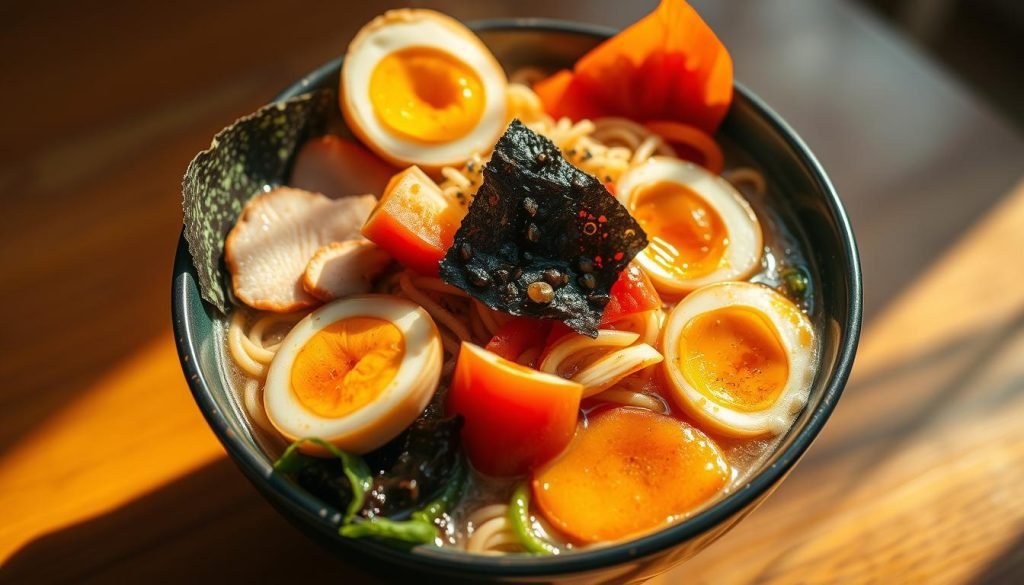
Customizing your ramen also means choosing toppings. You can add quick-cooking veggies or try ramen tacos. This makes your bowl a fun adventure.
Topping Choices and Cooking Techniques
Choosing the right toppings can make your ramen better. Soft boiled eggs come in five levels, and proteins like thinly sliced meats cook fast. They add a quick, tasty bite.
Here’s a look at some popular ramen toppings and their unique qualities:
| Topping | Flavor Profile | Preparation Time |
|---|---|---|
| Soft Boiled Eggs | Rich and Creamy | 5-7 minutes |
| Chashu Pork | Savory and Umami | 25-30 minutes |
| Bean Sprouts | Crunchy and Fresh | 1-2 minutes |
| Menma (Bamboo Shoots) | Nutty and Earthy | Pre-cooked |
Making custom ramen is all about trying new flavors and textures. Whether you like it spicy or with a tangy twist, there’s always something new to try. Personalizing your ramen is a fun way to be creative in the kitchen.
Tips for Perfecting Ramen at Home
To make perfect ramen at home, you need to know a few tricks. Cooking the noodles right and getting the flavors just right in your broth are key. Here are some tips to make your homemade ramen amazing.

Cooking Noodles to Perfection
The base of any perfect ramen is its noodles. Whether you make ramen from scratch or buy it, knowing how to cook noodles is crucial:
- Boiling Time: Cook noodles until they’re slightly firm, about 1-3 minutes. This depends on their thickness and type. Cooking them too long makes them soggy.
- Water Ratio: Use a big pot with lots of water to prevent noodles from sticking. Adding salt to the water boosts their flavor.
- Immediate Serving: Serve noodles right after boiling. They lose their texture fast.
Balancing Flavors in Your Broth
A great ramen broth is all about flavor balance. You need the right ingredients and careful prep. Here’s how:
- Ingredient Ratios: Traditional ramen broth is 4 parts chicken to 1 part water. This gives a rich flavor. French broth is 1:4, which is lighter.
- Simmering Time: For a deep flavor, simmer chicken and pork for at least 6 hours. Or, use a pressure cooker for 3 hours.
- Seasoning Variety: Try different salts like fleur de sel or Maldon to add depth to your broth.
| Element | Recommendation |
|---|---|
| Noodle Choice | Sun Noodles for authentic texture |
| Broth Base | 4 parts chicken to 1 part water |
| Simmering Time | 6 hours or 3 hours with a pressure cooker |
| Seasoning | Variety of salts (e.g., fleur de sel, Maldon) |
With these home cooking tips, you can make amazing ramen at home. Learning to cook ramen and noodle tips will improve your cooking. Plus, you’ll have a delicious dish to share with friends and family.
Ramen Pairings: Drinks and Sides That Complement
Adding the right drinks and side dishes to your ramen makes it better. It turns a simple meal into a feast for your taste buds. Finding the best pairings can make your ramen experience even more enjoyable.
Best Beverage Choices for Ramen
Sake or green tea are great drinks for ramen. They cool down the rich broth. Soju, a Korean drink, adds a bold flavor to spicy ramen.
Barley tea (Bori Cha) is a good choice because it’s caffeine-free. It matches the hearty taste of ramen. Makgeolli, a fizzy rice wine, balances the creamy ramen well.
Delicious Side Dishes to Serve Alongside
Side dishes can make your ramen meal exciting. Gyoza’s crispy texture is a nice contrast to soft noodles. Agedashi Tofu, fried and served in dashi broth, is very umami.
Edamame is healthy and tasty. Air Fryer Panko Shrimp is crispy and flavorful. Kimchi Pancakes mix Korean flavors with ramen for a unique taste.
Hijiki Salad adds nutrition and texture. Tamago (Japanese egg) brings protein and creamy taste. Chicken Yakitori is great for those who want more protein.
Choosing the right drinks and sides can make your ramen meal special. Try different pairings to find your favorite. Enjoy every sip and bite!